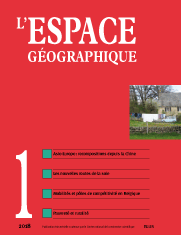

Eurasia, an unthought space in geography: Continent, empire, ideology or project? (1 fig.)
Geographers have rarely referred to Eurasia in their writings. Today, the Russian project of a Eurasian Economic Union and the Chinese New Silk Roads is changing the way we have viewed this continent and its maritime envelope using a geo-historical approach. Its western and eastern extremities at first largely ignored themselves. This continent was characterized until the beginning of the 20th century by the recurrence of imperial constructions. The rise of nation-state has accentuated its fragmentation and created zones of fractures and recurrent conflicts on the margins of former empires that have become great powers. Transport and economic corridors, under development or planned, continental or maritime, shape Eurasia. China is asserting itself as the main driver for the development of transport and communications infrastructures that will bring more cohesion to this continental ensemble. If it were an unthought geographical space, it may become now a significant space.
keywords: ASIA, CORRIDOR, EMPIRE, EUROPA, NATION-STATE, SILK ROAD
The Central Asian corridors of the new silk road: A new continental destiny for China (6 fig.)
After giving the priority to the development of its coastline, China makes its return in its continental hinterland. Within the framework of the New Silk Roads, the development of transport networks and the opening of borders make Xinjiang a new window leading to a process of transnational regionalisation in Central Asia. But Xinjiang is also a strategic territory for the spread of Chinese influence across Eurasia through the construction of transcontinental land bridge corridors.
keywords: CORRIDOR, SILK ROAD, TAX-FREE ZONE, TRANSNATIONAL REGIONALISATION
Residential basins in Belgium: Two methods, one reality? (11 fig.; 3 tabl.)
Migration flows are often used to capture the spatial organization of territories. With the explosive growth of large databases and information technologies, new tools (methods and data) are now available for researchers. Two spatial partitioning methods are here compared: Anabel (developed by INSEE) and the Louvain method (anchored in data sciences). The aim is to compare their advantages and disadvantages, while providing a critical geographical understanding of the results. Two databases are used: A theoretical and a real world data set (inter-communal migrations in Belgium, excluding the intramunicipal migrations). Results remind us that partitioning space is not a trivial exercise, that the results depend strongly on the methods and thresholds used, and that decisions related to the partitioning of a territory should always be done in a cautious and informed manner.
keywords: ANABEL, BELGIUM, INTERACTION, LOUVAIN METHOD, MIGRATION, SPATIAL PARTITIONNEMENT
The spatial structure of regional innovation system: What about the impact of geographic proximity within Wallon business clusters? (9 fig.; 1 tabl.)
Research on regional innovation systems suffers from a lack of clarity concerning the spatial structure of these systems. In order to clarify this issue, we test empirically, through data on research and development projects developed by the Walloon competitiveness clusters, the theoretical assumption according to which the probability that two actors collaborate to innovate is correlated to the spatial distance separating them. Our analyses use the differentiation between the logics of “local buzz” and “global pipelines” formulated by the model of Harald Bathelt et al. (2004). As our results highlight the structuring character of the Walloon regional level, we propose an improvement of this model by supplementing it with a reference to the “regional pipelines” logic. It also appears from our results that the relations between partners of research and development projects are particularly intense when the spatial distance between them is below 10 kilometers, which is a mark of a significant “local buzz” dynamic.
keywords: BELGIUM, BUSINESS CLUSTERS, GEOGRAPHIC PROXIMITY, INNOVATION, REGIONAL DEVELOPMENT, WALLONIA
Investigating the geography of rural poverty and precariousness in medium-height mountain
Poverty in rural areas has held social science’s attention. However, it has rarely been a research topic analysed by itself. This paper shows how rural space’s peculiarities and medium mountain’s constraints have an effect on poverty and precarity situations. These links can reveal as well vicious circles as resilience from the inhabitants.
keywords: MOBILITY, MOUNTAIN, POVERTY, PRECARITY, REMOTENESS, RUR
Book reviews
In this issue of l’Espace géographique, you will find critical reviews of the following books
BÉTHEMONT J., BRAVARD J.-P. (2016). Pour saluer le Rhône. Lyon: Éditions Libel, 400 p. (David Blanchon, université Paris Nanterre) ISBN: 978-2-917659-50-2
PINOT A., REVEILLARD C. (dir.)(2016). Russie d’hier et d’aujourd’hui, perceptions croisées. Paris: Éditions SPM, 316 p. (Claude Bataillon, Cnrs Toulouse) ISBN: 978-2-917232-53-8
MATHIEU N. (2017). Les Relations villes/campagnes. Histoire d’une question politique et scientifique. Paris: L’Harmattan, coll. «Logiques sociales» 240 p. (Yves Guermond, université de Rouen, UMR IDEES) ISBN: 978-2-343-12712-5
For subscribe or buy this issue: BELIN
![]() L’Espace géographique: contents
L’Espace géographique: contents
Last modified: June 14, 2018